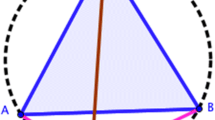Abstract
This study offers a view on students’ technology-based problem solving activity through the lens of a theoretical model which accounts for the relationship between mathematical and technological knowledge in successful problem solving. This study takes a qualitative approach building on the work of a 13-year-old girl as an exemplary case of the nature of young students’ spontaneous mathematical problem solving with technology. The empirical data comprise digital records of her approaches to two problems from a web-based mathematical competition where she resorted to GeoGebra and an interview where she explains and describes her usual problem solving activity with this tool. Based on a proposed model for describing the processes of mathematical problem solving with technologies (MPST), the main results show that this student’s solving and expressing the solution are held from the early and continuing interplay between mathematical skills and the perception of the affordances of the tool. The analytical model offers a clear picture of the type of actions that lead to the solution of each problem, revealing the student’s ability to deal with mathematics and technology in problem solving. By acknowledging this as a case of a human-with-media in solving mathematical problems, the students’ efficient way of merging technological and mathematical knowledge is portrayed in terms of her techno-mathematical fluency.










Similar content being viewed by others
References
Barbeau, E. J. & Taylor, P. (Eds.). (2009). Challenging mathematics in and beyond the classroom: The 16th ICMI study. New York, NY: Springer.
Barron, B., Martin, C. & Roberts, E. (2007). Sparking self-sustained learning: report on a design experiment to build technological fluency and bridge divides. International Journal of Technology and Design Education, 17(1), 75–105.
Borba, M. & Villarreal, M. (2005). Humans-with-media and the reorganization of mathematical thinking. New York, NY: Springer.
Carreira, S., Jones, K., Amado, N., Jacinto, H., & Nobre, S. (2016). Youngsters solving mathematical problems with technology: The results and implications of the Problem@Web Project. New York, NY: Springer.
Chemero, A. (2003). An outline of a theory of affordances. Ecological Psychology, 15(2), 181–195.
Crockett, L., Jukes, I. & Churches, A. (2012). Literacy is NOT enough: 21st century fluencies for the digital age. New York, NY: Corwin Press.
Day, D. & Lloyd, M. (2007). Affordances of online technologies: More than the properties of the technology. Australian Educational Computing, 22(2), 17–21.
Dooley, L. (2002). Case study research and theory building. Advances in Developing Human Resources, 4(3), 335–354.
Drijvers, P., Kieran, C., Mariotti, M.-A., Ainley, J., Andresen, M., Chan, Y., ...Meagher, M. (2010). Integrating technology into mathematics education: Theoretical perspectives. In C. Hoyles & J.-B. Lagrange (Eds.), Mathematics education and technology-rethinking the terrain (pp. 89–132). New York, NY: Springer.
Gibson, J. (1979). The theory of affordances. In R. Shaw & J. Bransford (Eds.), Perceiving, acting, and knowing: Toward an ecological psychology (pp. 67–82). Hillsdale, NJ: Erlbaum.
Greeno, J. (1994). Gibson’s affordances. Psychological Review, 101(2), 336–342.
Hoyles, C., Noss, R., Kent, P. & Bakker, A. (2010). Improving mathematics at work: The need for techno-mathematical literacies. London, UK: Routledge.
Hoyles, C., Wolf, A., Molyneux-Hodgson, S. & Kent, P. (2002). Mathematical skills in the workplace: final report to the Science Technology and Mathematics Council. London, UK: Institute of Education, University of London; Science, Technology and Mathematics Council.
Jacinto, H., & Carreira, S. (2013). Beyond-school mathematical problem solving: a case of students-with-media. In A. M. Lindmeier & A. Heinze (Eds.), Proceedings of the 37th Conference of the International Group for the Psychology of Mathematics Education, (Vol. 3, pp. 105–112). Kiel, Germany: PME.
Kent, P., Noss, R., Guile, D., Hoyles, C. & Bakker, A. (2007). Characterizing the use of mathematical knowledge in boundary-crossing situations at work. Mind, Culture, and Activity, 14(1-2), 64–82.
Lesh, R. (2000). Beyond constructivism: Identifying mathematical abilities that are most needed for success beyond school in an age of information. Mathematics Education Research Journal, 12(3), 177–195.
Lesh, R. & Doerr, H. (2003). Foundations of a models and modeling perspective on mathematics teaching, learning, and problem solving. In R. Lesh & H. Doerr (Eds.), Beyond constructivism – models and modeling perspectives on mathematics problem solving, learning, and teaching (pp. 3–33). Mahwah: Erlbaum Associates.
Llinares, S. & Roig, A. (2008). Secondary school students’ construction and use of mathematical models in solving word problems. International Journal of Science and Mathematics Education, 6, 505–532.
Martin, A. (2006). A European framework for digital literacy. Digital Kompetanse, 2, 151–161.
Martin, A. & Grudziecki, J. (2006). DigEuLit: Concepts and tools for digital literacy development. Innovation in Teaching and Learning in Information and Computer Sciences, 5(4), 249–267.
Papert, S. & Resnick, M. (1995). Technological fluency and the representation of knowledge. Proposal to the National Science Foundation. Cambridge, UK: MIT Media Laboratory.
Pólya, G. (1945). How to solve it: A new aspect of mathematical method. London, UK: Penguin.
Quivy, R. & Campenhoudt, L. (2008). Manual de Investigação em Ciências Sociais [Research Manual in Social Science]. Lisboa, Portugal: Gradiva.
Santos-Trigo, M. & Camacho-Machín, M. (2013). Framing the use of computational technology in problem solving approaches. The Mathematics Enthusiast, 1–2, 279–302.
Schoenfeld, A. (1985). Mathematical problem solving. New York, NY: Academic.
Stahl, G. (2009) (Ed.). Studying Virtual Math Teams. New York, NY: Springer.
Villarreal, M. & Borba, M. (2010). Collectives of humans-with-media in mathematics education: notebooks, blackboards, calculators, computers and… notebooks throughout 100 years of ICMI. ZDM, 42(1), 49–62.
Zevenbergen, R. & Zevenbergen, K. (2009). The numeracies of boatbuilding: new numeracies shaped by workplace technologies. International Journal of Science and Mathematics Education, 7, 183–206.
Acknowledgments
This work was supported by the project Problem@Web (PTDC/CPE-CED/101635/2008) and the PhD grant SFRH/BD/73363/2010, both funded by Fundação para a Ciência e Tecnologia.
Author information
Authors and Affiliations
Corresponding authors
Rights and permissions
About this article
Cite this article
Jacinto, H., Carreira, S. Mathematical Problem Solving with Technology: the Techno-Mathematical Fluency of a Student-with-GeoGebra. Int J of Sci and Math Educ 15, 1115–1136 (2017). https://doi.org/10.1007/s10763-016-9728-8
Received:
Accepted:
Published:
Issue Date:
DOI: https://doi.org/10.1007/s10763-016-9728-8




